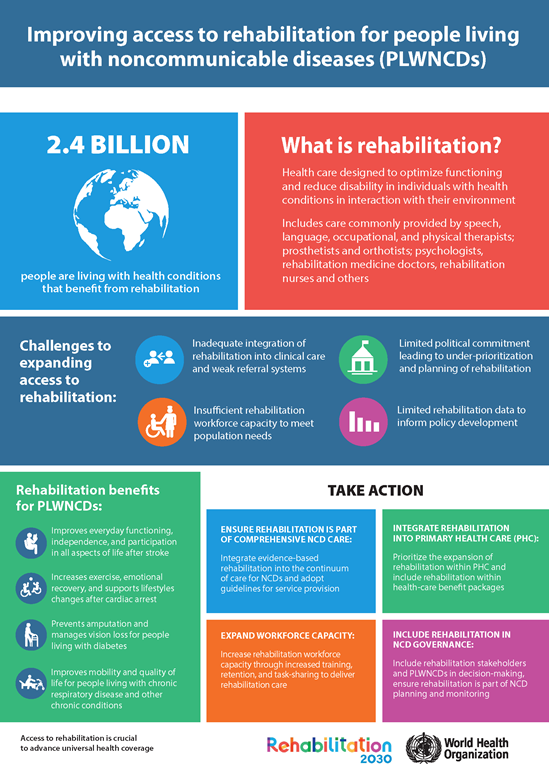Rehabilitation
Rehabilitation addresses the impact of a health condition
on a person’s everyday life by optimizing their functioning and reducing their
experience of disability. Rehabilitation expands the focus of health beyond
preventative and curative care to ensure people with a health condition can
remain as independent as possible and participate in education, work and
meaningful life roles. Anyone may need rehabilitation at some point in their
lives, whether they have experienced an injury, disease, illness, or because
their functioning has declined with age.
Globally, 1 in 3 people today are estimated to be living
with a health condition that would benefit from rehabilitation. This need is
predicted to increase in the coming years due to changes in the health and characteristics
of the population. For example, people are living longer but with more chronic
disease and disability. Emergencies, including conflicts, disasters and
outbreaks can all create surges in rehabilitation needs. Globally, many people
are living with mid- and long-term consequences of COVID-19 and may be in need
of rehabilitation to support their recovery from the disease.
Although the need for rehabilitation is increasing
globally, many countries are unequipped to respond to existing needs. In some
low- and middle-income countries, more than 50% of people do not receive the
rehabilitation services they require. Rehabilitation services are often under
funded and under valued, particularly in countries without strong health
systems.
Rehabilitation helps to reduce the impacts of disease and
injury on individuals, while also complimenting other health interventions. This
means it can be seen as an investment in health care costs because it can lower
long term reliance on health systems through reducing hospitalization, shortening
hospital stays and preventing readmissions. The investment pays off further by enabling
people to return to work, education and other pursuits more quickly following the
health issue.
Rehabilitation is a neglected but essential part of emergency
response and long-term recovery. Emergencies disproportionately effect weaker
health systems and the most vulnerable, but early and ongoing access to
rehabilitation reduces complications, optimizes functioning and reduces
disability in those affected, supporting individuals, families and communities
in their recovery.
WHO views rehabilitation as an essential part of achieving both
universal health coverage and goal 3 of the Sustainable Development Goals. To
this end, WHO works to make rehabilitation part of health care at all levels
through efforts to strengthen health systems as a whole.
In 2017 WHO launched the Rehabilitation 2030
initiative, which emphasizes the need for concerted and coordinated action
by all stakeholders to strengthen the health system to provide quality and
timely rehabilitation. This occurs through actions such as improving leadership
and governance; developing a strong multidisciplinary rehabilitation workforce;
expanding financing for rehabilitation; and improving data collection and
research on rehabilitation. In emergencies, we are developing tools to help
strengthen rehabilitation preparedness, while also working to better integrate
rehabilitation into responses.
WHO continues to support countries to implement these
actions through providing technical support, developing guidance and practical
tools, and increasing the development of robust evidence for rehabilitation. These
efforts focus both on local and national health systems, as well as responses
to emergencies to ensure rehabilitation services are available to anyone who
needs them.


















